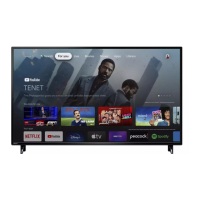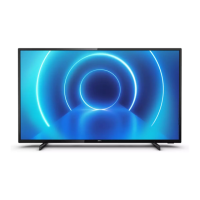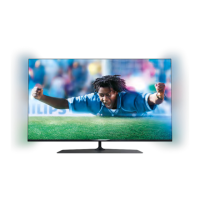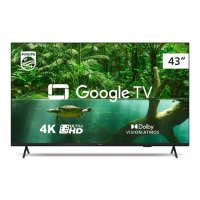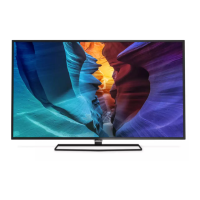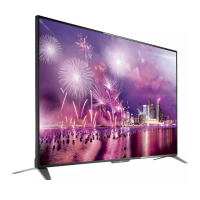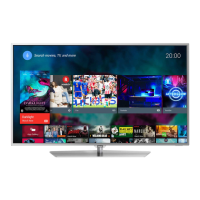
Do you have a question about the Philips 7101 series and is the answer not in the manual?
Describes the unified source menu and its features for TV navigation.
Explains the Top Picks feature for recommended TV programs and services.
Details how to browse and manage media files like videos, songs, and photos on the TV.
Explains the benefits and features of the TV's Ultra HD display technology.
Describes how HDR technology enhances picture brightness, contrast, and color saturation.
Introduces the Android TV platform, apps, and connectivity features for a smart TV experience.
Guides on how to watch TV channels, manage favorites, and use TV Guide features.
Explains how to use pre-installed and downloaded applications for various TV functions and entertainment.
Details how to use the TV as a gaming platform, including settings for optimal gameplay.
Describes how to pause live TV broadcasts and record programs using a USB hard drive.
Covers connecting and using smartphones/tablets with the TV, including the remote app and casting.
Introduces Ambilight, the TV's unique ambient lighting feature for an immersive viewing experience.
Describes extending the Ambilight experience using Philips Hue wireless bulbs for ambient lighting.
Explains how to connect wireless Bluetooth devices like speakers and headphones to the TV.
Emphasizes the importance of reading all safety instructions before using the TV to prevent hazards.
Provides guidance on installing the TV stand or mounting it securely on a wall.
Offers advice on optimal TV placement for viewing comfort and Ambilight effect.
Details the correct procedure for connecting and disconnecting the TV's power cable safely.
Explains how to connect an antenna cable for receiving DVB-T and DVB-C signals.
Describes how to connect a satellite dish using an F-type connector for satellite TV reception.
Guides on connecting the TV to a home network for internet access via wired or wireless connection.
Explains how to sign in with a Google Account to access Android TV features and apps.
Details how to access and install apps from the Philips App Gallery for TV-specific content.
Provides a general overview of connecting various devices to the TV for optimal picture and sound quality.
Explains how to use a CAM module and smart card for accessing premium HD TV channels.
Details how to connect a set-top box or digital receiver to the TV using antenna and HDMI cables.
Guides on connecting a Home Theatre System (HTS) via HDMI ARC for enhanced audio output.
Covers connecting smartphones and tablets to the TV wirelessly or via wired connections like MHL.
Explains how to connect a Blu-ray disc player to the TV using an HDMI cable for playback.
Details how to connect a DVD player to the TV using an HDMI or SCART cable for movie playback.
Covers connecting Bluetooth speakers, subwoofers, soundbars, and gamepads to the TV.
Explains how to connect headphones to the TV's mini-jack port and adjust their volume.
Provides instructions for connecting game consoles via HDMI, YPbPr, or SCART for gaming.
Details how to connect gamepads, both wired and Bluetooth, for playing games on the TV.
Explains how to connect and format a USB Hard Drive for pausing and recording TV broadcasts.
Describes how to connect and configure a USB keyboard for text input on the TV.
Explains how to view photos, play music, and videos from a USB flash drive.
Guides on connecting a digital photo camera to the TV to view photos.
Explains how to connect a camcorder to the TV using HDMI or SCART connections.
Details how to connect a computer to the TV to use it as a PC monitor.
Explains how to switch the TV on, put it in standby mode, and disconnect power.
Describes how to adjust or turn off the brightness of the Philips logo on the TV.
Details how to operate the TV using the physical buttons on the unit if the remote control is lost.
Explains how to set a timer to automatically switch the TV to standby after a preset time.
Describes the automatic switch-off feature and how to deactivate it to save energy.
Provides a detailed layout and function description of all buttons on the TV remote control.
Guides on how to use voice search functionality via a smartphone app or built-in features.
Explains the operation of the remote control's built-in keyboard for text input and layout settings.
Describes the function of the infrared sensor for remote control commands.
Details how to replace the batteries in the remote control.
Provides instructions for cleaning the remote control safely.
Guides on how to search for and install TV channels using antenna, cable, or satellite tuners.
Explains how to view, filter, and manage channel lists, including favorites and icons.
Covers tuning to channels, switching between them, locking channels, and setting parental ratings.
Explains how to set primary and secondary subtitle languages for digital broadcasts.
Describes how to temporarily select a subtitle language when preferred options are not available.
Explains how to set primary and secondary audio languages for digital broadcasts.
Describes how to temporarily select an audio language when preferred options are not available.
Explains how to block HbbTV pages for a specific channel to avoid unwanted access.
Describes how to switch the audio output of an analog channel between Mono and Stereo.
Guides on creating, naming, and managing lists of favorite channels for easier zapping.
Explains how to add a consecutive range of channels to a favorite list at once.
Details how to rename a created favorite channels list.
Guides on how to delete a created favorite channels list.
Explains how to change the sequence of channels within a favorite list.
Covers opening, closing, and navigating Teletext pages for information and interactive services.
Explains how to set the primary and secondary text languages for Teletext broadcasts.
Describes the Text 2.5 feature for enhanced graphics and colors in Teletext.
Introduces interactive TV services like HbbTV and MHEG for engaging with content.
Outlines prerequisites for using the TV Guide, such as channel installation and internet connection.
Explains the sources of TV guide information (broadcaster or internet) and potential data availability issues.
Covers opening the TV Guide, tuning to programs, viewing details, and setting reminders.
Details how to schedule a program recording directly from the TV Guide interface.
Explains the process of recording digital TV broadcasts, including requirements and procedures.
Guides on scheduling future program recordings using TV Guide data.
Addresses how to manage overlapping scheduled recordings and adjust their times.
Explains how to set an automatic time margin for the end of scheduled recordings.
Describes how to schedule recordings manually without relying on TV Guide data.
Guides on how to play back recorded programs and use playback controls.
Explains how to pause live TV broadcasts and resume watching later.
Introduces the Top Picks feature, recommending content based on user preferences and services.
Outlines the terms and conditions required to use personalized recommendations and services.
Explains the "Now on TV" feature which suggests popular programs currently airing or starting soon.
Guides on how to access and interact with the "Now on TV" feature for program selection.
Describes the "TV on Demand" service for watching missed or favorite programs at any time.
Explains how to rent movies from an online store and manage payment and internet traffic.
Introduces the Home menu as the central hub for navigating apps, channels, and settings on Android TV.
Provides instructions on how to access and navigate items within the Home menu.
Explains how to search for content on the internet using voice commands or text input.
Details how to set up a restricted profile to limit access to specific apps and settings for child safety.
Describes the TV Menu as an alternative to the Home menu when internet connection is unavailable.
Provides instructions on how to access and navigate the TV Menu.
Guides on switching between connected devices and TV tuners via the Sources menu.
Explains how to set specific options for individual TV input sources like HDMI or USB.
Describes how to assign names and types to connected devices for easier identification in the Sources menu.
Explains how to set ideal picture and sound settings for gaming consoles or computers.
Introduces the Apps section, explaining how to find and use TV applications for various functions.
Details how to use Google Play for Movies & TV, Music, and Games, requiring internet and Google Account.
Explains how to download and install new apps from the Google Play Store, including parental controls.
Guides on accessing and installing apps specifically selected by Philips from the App Gallery.
Describes how to launch and close applications from the Home menu.
Explains how to lock 18+ rated apps or set up a restricted profile for child safety.
Details how to stop apps, clear cache, and uninstall unused applications to optimize performance.
Explains how to check TV memory usage and free space for apps and media.
Outlines prerequisites for playing games, including internet connection and app installation.
Covers connecting wireless gamepads for playing games on the TV.
Guides on starting games from the Home menu or a connected game console.
Explains how the TV automatically optimizes settings for games or how to adjust them manually.
Guides on how to launch the TV's internet browser to surf websites.
Details available options within the internet browser, such as entering addresses and managing favorites.
Explains how to view media files stored on a USB flash drive or hard drive connected to the TV.
Guides on accessing and playing media files shared from a computer or NAS on the home network.
Details how to view photos or play media from cloud storage services using the Cloud Explorer app.
Explains how to play video files from various sources, including controls and progress bar.
Guides on viewing photos, starting slideshows, and accessing photo information.
Describes how to create a photo slideshow accompanied by music.
Explains how to play music files from various sources, including controls and music options.
Introduces the Philips TV Remote App for controlling the TV and managing media from a smartphone or tablet.
Explains how to cast apps and content from mobile devices to the TV using Google Cast.
Describes how to add AirPlay functionality to the Android TV via compatible apps.
Explains MHL connectivity for sharing mobile device screens and charging the device via HDMI.
Details how to set Ambilight to follow video, audio, or select preset color styles for ambient lighting.
Explains how to switch off the Ambilight feature completely.
Covers advanced settings for Ambilight, including brightness, saturation, and wall color influence.
Introduces the Multi View feature for displaying multiple video sources simultaneously on the TV screen.
Explains how to watch a TV channel in a small screen while viewing Teletext.
Describes viewing a TV channel in a small screen alongside a Nettv app.
Explains how to watch a TV channel in a small screen while viewing video from an HDMI device.
Covers adjusting various picture settings like style, color, contrast, and sharpness for optimal viewing.
Details advanced picture adjustments including Game/Computer mode, Color, and Sharpness settings.
Explains color settings like Hue, Saturation, and Reset All for fine-tuning picture colors.
Covers contrast adjustments including modes, dynamic contrast, perfect contrast, and brightness.
Describes how to adjust the range of video contrast for picture enhancement.
Explains how the light sensor automatically adjusts picture settings based on room lighting.
Details Gamma settings for non-linear picture luminance and contrast adjustment.
Covers sharpness adjustments like Ultra Resolution and Noise Reduction for clearer image details.
Explains how to smoothen digital transitions and reduce jagged edges in images.
Details motion settings like Perfect Natural Motion and Clear LCD for smoother and sharper motion.
Guides on adjusting the picture to fit the screen using basic or advanced formatting options.
Covers adjusting sound parameters like Bass, Treble, and Surround Mode for optimal audio output.
Allows selection of preset sound styles (Personal, Movie, Music, Game, News) for different audio experiences.
Explains how to reset sound styles to their original factory settings.
Covers adjusting sound parameters like Bass, Treble, and Surround Mode for optimal audio output.
Details advanced audio adjustments including Auto Volume Levelling, Clear Sound, and Audio Out options.
Explains how to adjust the volume for connected headphones independently.
Guides on selecting TV speakers or connected audio devices for sound output, including EasyLink Autostart.
Covers changing TV menus, messages, and setting preferences for region and language.
Explains how to change the display language for TV menus and messages.
Details how to set preferred primary and secondary audio languages for programs.
Explains how to switch subtitles on/off, set automatic display, and select subtitle languages.
Guides on manually enabling subtitles for analogue channels using Teletext.
Covers setting preferred primary and secondary text languages for Teletext content.
Explains how to set the TV clock automatically or manually, including time zone adjustments.
Details features for users with hearing or visual impairments, including audio description and speech options.
Explains how to enable Universal Access features for accessibility.
Describes how to activate "Hearing impaired" settings for adapted audio and subtitles.
Guides on enabling audio description for visually impaired users.
Allows selection of audio output between TV speakers, headphones, or both.
Explains how to mix normal audio volume with audio commentary volume.
Describes how to activate additional audio effects like stereo or fading sound for commentary.
Explains how to enable subtitles for spoken words in audio commentary.
Provides information on connecting the TV to a network for internet access.
Covers connecting wireless Bluetooth devices like speakers, headphones, and gamepads.
Guides on updating channels, managing update messages, and reinstalling channels for antenna/cable reception.
Details how to reinstall all channels while keeping other TV settings intact.
Explains how to perform a full TV reinstallation, resetting all settings and reinstalling channels.
Covers DVB settings including network frequency, scan methods, step size, and digital/analogue channels.
Explains how to select channels based on subscription status (free or scrambled).
Guides on checking and improving digital channel reception quality.
Details how to manually install analogue TV channels one by one.
Guides on installing satellites, selecting numbers, Unicable systems, and homing transponders.
Explains how to use Satellite CAMs (Conditional Access Modules) for watching satellite channels.
Describes how satellite operators offer channel packages and installation options.
Details the Unicable system for connecting satellite dishes and assigning user band numbers.
Explains manual installation of channels from a satellite transponder for expert users.
Guides on copying the current channel list to a USB drive and uploading it to another TV.
Explains how to upload a previously copied channel list to the TV.
Guides on updating TV software from the internet or a USB flash drive to improve functionality.
Explains how to perform software updates wirelessly via an internet connection.
Details the process of updating TV software using a USB flash drive and a computer.
Shows how to view the current TV software version, release notes, and creation date.
Provides information about the open source software used in the television and how to obtain source code.
Explains how to view announcements regarding new TV software or related issues.
Provides information on the European Energy Label, energy efficiency, and product disposal guidelines.
Lists detailed technical specifications and energy consumption data for different TV models.
Guides on the proper disposal of old products and batteries according to environmental regulations.
Details the power requirements, ambient temperature range, and power-saving features of the TV.
Specifies the operating system used by the TV, Android Lollipop 5.1.
Lists the TV's reception capabilities, including tuner types, DVB standards, and input specifications.
Provides details on the TV's screen size and resolution specifications.
Lists supported video and computer input resolutions and refresh rates.
Specifies the physical dimensions and weight of the TV with and without the stand for different models.
Lists all available TV ports and connection types, including HDMI, USB, and network interfaces.
Details the TV's sound features, including WOOX, HD Stereo, output power, and Dolby/DTS support.
Lists supported connections, file systems, playback formats for video, audio, and subtitles.
Encourages TV registration for benefits like full support, new product information, and prize opportunities.
Guides on accessing the on-screen help system, user manual, and downloading help files to other devices.
Provides solutions for common TV issues like not switching on, remote control problems, and sound/picture issues.
Directs users to the Philips support website for troubleshooting, FAQs, and contacting customer care.
Advises on contacting Philips Customer Care for support, repair services, and finding model/serial numbers.
Provides critical safety warnings regarding electric shock, fire hazards, and physical injury prevention.
Emphasizes using wall brackets and stands to prevent the TV from tipping over, especially around children.
Lists precautions to prevent electrical hazards like water exposure and heat.
Warns about safe handling, lifting, and connecting the TV to power outlets with correct voltage.
Provides precautions to prevent children from accessing small parts or climbing furniture, like batteries.
Advises on ensuring adequate ventilation around the TV to prevent overheating.
Recommends disconnecting the TV during lightning storms to prevent damage.
Warns about potential hearing damage from using headphones at high volumes.
Advises on acclimatizing the TV to room temperature after exposure to low temperatures.
Addresses potential minor condensation on the screen due to humidity and temperature.
Provides instructions for cleaning the TV screen and frame gently without using harsh chemicals.
States the general terms of use, warranty information, and product specifications, including CE compliance.
Explains how to access and set terms of use, privacy policy, and privacy settings for Smart TV features.
Guides on finding more information about terms of use for the Philips App Gallery.
Mentions MHL trademarks and registered trademarks.
States that the UHD Display Logo is a DIGITALEUROPE trademark.
Lists HDMI and HDMI High-Definition Multimedia Interface as trademarks.
Mentions Dolby trademarks and licensing information.
Provides DTS patent information and trademark details.
Mentions Windows Media and PlayReady trademarks and content protection technology.
States that Wi-Fi and its logos are registered trademarks of the Wi-Fi Alliance.
Lists Kensington and Micro Saver as registered US trademarks.
States that all other trademarks are property of their respective owners.
